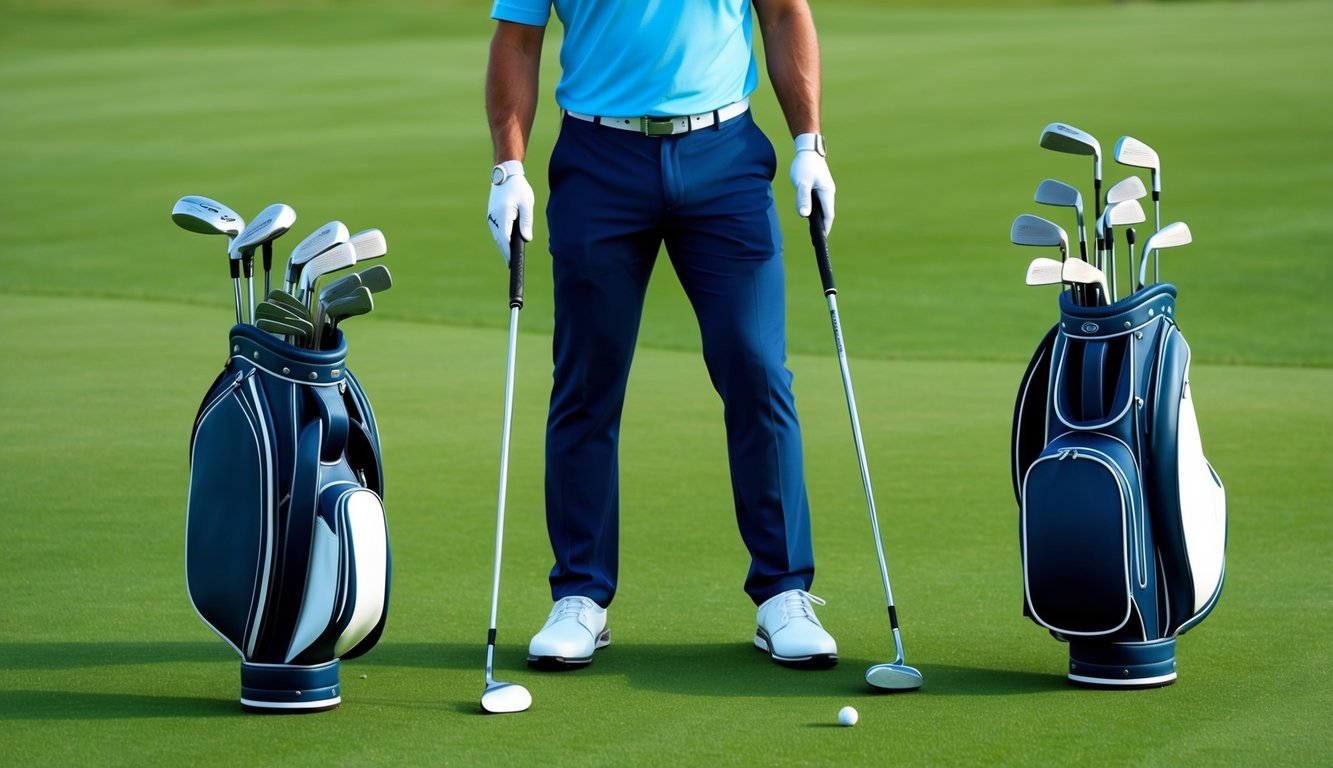Choosing between a pitching wedge and a sand wedge can seem daunting, but it boils down to understanding the distinct roles they play in your game.
The pitching wedge is tailored for slightly longer approach shots, offering precision and versatility.
A sand wedge excels in bunkers and lies with higher grass, delivering increased control and spin.
Knowing when to use each can drastically transform your short game.

Imagine stepping onto the golf course equipped with the knowledge to decide effectively between these wedges.
You can confidently select the right club, enhancing your performance on varying terrains.
This article aims to guide you through the nuances of these essential golf tools, ensuring you make informed choices that suit various playing conditions.
Mastering the intricacies of the pitching and sand wedges will elevate your game from good to great.
Understanding their differences and implementing strategic use can provide you with an advantage over challenging situations.
Dive in to explore tips and techniques that cater to all levels of play, refining your skills and boosting your confidence on the green.
Key Takeaways
- Pitching wedges are versatile for longer approaches.
- Sand wedges provide control in bunkers or tall grass.
- Strategic use enhances your short game.
Understanding Golf Wedges
Golf wedges are versatile clubs designed to help you tackle various shots on the course.
This section explores different types of wedges and their components, helping you understand how to choose and use them effectively for both distance and precision in your game.
Types of Wedges
Wedges are crucial for short distances and high-lofted shots.
The main types include the pitching wedge, sand wedge, lob wedge, and gap wedge.
A pitching wedge, typically with a loft angle between 44 to 49 degrees, offers distance and accuracy from the fairway.
It is widely used for approaches and chips where longer reach is necessary.
The sand wedge has a higher loft angle, often between 54 and 58 degrees.
It’s ideal for escaping bunkers and hitting from heavy rough.
With its pronounced bounce angle, it prevents the club from digging into sand or turf.
A lob wedge, with loft exceeding 60 degrees, enables steep, controlled shots to clear obstacles.
The gap wedge fills the distance gap between the pitching and sand wedges, providing a loft around 50 to 54 degrees.
Anatomy of a Wedge
Understanding the anatomy of a wedge helps you select the right club for specific situations.
The loft angle determines the trajectory and spin, affecting how high and far the ball travels.
Meanwhile, the bounce angle is crucial for performance in sand and rough; higher bounce reduces digging into soft surfaces.
Clubhead design includes the sole grind, which adapts to various lies.
Some wedges have narrower soles for versatility.
Grooves on the face enhance spin and control, especially in wet conditions.
Meanwhile, the shaft should match your swing style to ensure consistency.
By knowing the characteristics of each wedge component, you can better control your shots and improve your short game.
Pitching Wedge Explained
The pitching wedge is an essential club in your iron set, balancing between loft and distance.
This club is particularly useful for beginners and experienced golfers alike, offering versatility for various shot types.
Ideal Conditions for a Pitching Wedge
A pitching wedge is most effective on fairway shots and when approaching greens.
Its loft, typically between 44 and 50 degrees, allows for more control and accuracy compared to longer irons.
You can expect it to cover distances of about 110 to 135 yards for full swings, although this can vary based on your skill level and swing speed.
It’s vital for executing pitch shots where you wish for the ball to fly high and land softly on the green.
For beginners, the pitching wedge offers a great opportunity to improve accuracy due to its manageable loft and shaft length.
Technique and Shot Types
When using a pitching wedge, focus on maintaining a relaxed grip and a smooth swing.
For full swings, ensure you balance the power with control to maximize distance.
Use the pitching wedge for shorter pitch shots by adjusting your stance and reducing your swing length, perfect for navigating tricky areas around the green.
This club excels in various shot types, making it a go-to in your arsenal.
Practicing different shot scenarios will improve your confidence and ability to execute under diverse conditions.
Sand Wedge Explained

A sand wedge is a versatile golf club, essential for improving your performance in challenging conditions like sand traps or thick grass.
Its unique design helps you navigate obstacles and execute greenside bunker shots with precision.
Navigating Bunkers and Obstacles
When you find yourself in a bunker or sand trap, the sand wedge is your go-to club.
Its design features a wider sole and a higher loft, which are critical for lifting the ball out of the sand with ease.
The bounce on the sand wedge is instrumental in preventing the club from digging into the sand.
This bounce angle helps the club glide through the sand, allowing you to effectively execute bunker shots and get back onto the fairway or green.
Additionally, the sand wedge is ideal for situations where thick grass or rough terrain is your obstacle.
You can use it to pop the ball up and over obstacles, giving you the control and lift needed to clear tricky situations.
The wedge’s specialized design makes it easier to recover from mishits and continue playing with confidence.
When to Use a Sand Wedge
You should consider using a sand wedge when you’re faced with greenside bunker shots or when your ball is in a difficult lie.
This club is especially designed for short, high-lofted shots, often within 80-100 yards.
Its high loft, typically between 54 and 58 degrees, allows for precise shots over hazards such as bunkers and onto the green.
For chip shots and delicate flop shots around the green, the sand wedge provides the necessary height and spin, making it easier to stop the ball close to the hole.
When the grass gets thick or uneven, a sand wedge is preferable to a pitching wedge due to its superior ability to navigate through rough conditions effectively.
Using a sand wedge strategically enhances your ability to maintain control and accuracy during your short game, ultimately improving your overall performance on the course.
Comparing Pitching Wedge and Sand Wedge

Understanding the differences between a pitching wedge and a sand wedge can significantly impact your game.
Each wedge has unique characteristics that affect distance, loft, and versatility.
Let’s explore these key aspects to help you select the right club for every shot.
Lofts and Distances
A pitching wedge typically has a loft angle between 44 and 50 degrees.
This lower loft allows for greater distance and a more penetrating trajectory.
On a clean fairway, you can expect a pitching wedge to cover about 100 yards.
This makes it an ideal choice when you need to cover more ground with accuracy.
In contrast, a sand wedge has a higher loft of around 54 to 58 degrees, allowing you to hit the ball higher and add more spin.
This makes the sand wedge perfect for situations like bunkers or thick grass, where you need to lift the ball quickly.
The higher loft provides better stopping power and improved short-game control, especially around the green.
Choosing Between the Two
Consider different factors when choosing between a pitching wedge and a sand wedge. Course conditions play a crucial role, as soft sand or thick grass might necessitate the use of a sand wedge.
Meanwhile, a pitching wedge can be more suitable for firmer lies and longer target distances.
Distance control and the trajectory are also important.
If you need a shot with more roll and less loft, go for the pitching wedge.
The sand wedge is best used when you require precise landing with minimal roll.
Think about your own skill level as well.
Beginners might find more confidence in a sand wedge for its forgiving nature, especially in tricky terrain.
As you get comfortable navigating different situations, mixing a gap wedge into your game may also enhance your shot-making versatility and fill in any distance gaps.
Advanced Techniques and Tips

Mastering the use of pitching and sand wedges involves perfecting your short game to reduce strokes and keeping your clubs in top condition.
You’ll find insights on improving your skills at greenside play, from avoiding chunking to maximizing backspin and maintaining your wedges for optimal performance.
Improving Your Short Game
Fine-tuning your short game is crucial for lowering your scores.
Focus on techniques like chipping and executing precise chip shots.
Perfecting a bump and run can help you manage various lies around the greens.
You may practice flop shots for high-lofted shots that land softly.
Avoid trapping the ball too much, which leads to chunking.
Instead, aim for clean contact to boost consistency and control your swing speed effectively.
Incorporating drills that emphasize backspin will also enhance your ability to stop the ball near the hole.
Instructional videos and tips from professional players can offer valuable insights into refining your technique.
Club Care and Maintenance
Proper maintenance of your wedges extends their life and improves performance.
After each round, you should clean the clubface of dirt and grass to maintain the grooves’ effectiveness.
Use a soft brush and water for routine cleaning, and a specialized cleaning agent for deeper grime.
Regularly check the grip condition, as a worn grip can affect your swing.
Replace grips when necessary for a secure hold.
Store your clubs in a dry environment and consider head covers to protect from damage.
Many manufacturers provide specific care instructions, which can ensure your wedges remain versatile tools in your golf bag.

